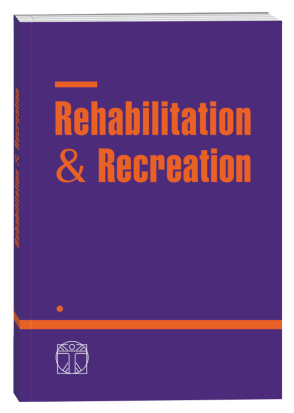ASSESSMENT OF THE EFFECTIVENESS OF THE EFFECT OF PHYSICAL THERAPY ON THE DYNAMICS OF ASTHENO-DEPRESSIVE MANIFESTATIONS IN WOMEN AFTER ABDOMINAL DELIVERY
DOI:
https://doi.org/10.32782/2522-1795.2023.15.4Keywords:
rehabilitation, physical therapy, postpartum period, caesarean section, abdominal delivery.Abstract
Purpose: Resume. Purpose: to determine the effectiveness of physical therapy in women after abdominal delivery according to the dynamics of astheno-depressive manifestations. Material. 45 women aged 23.7±1.2 years, in the late postpartum period after abdominal delivery (caesarean section) were examined. The comparison group consisted of 23 women who recovered during the postpartum period on their own, according to general recommendations. The main group consisted of 22 women who during the late postpartum period (1.5 months) underwent a physical therapy program (classes using breathing exercises and yoga exercises, Pilates exercises for the muscles of the back, abdomen, upper and lower limbs, therapeutic exercises for general strengthening body, increasing strength, flexibility, endurance; general massage; autogenic training sessions according to Schultz). The condition of women was evaluated according to the results of the Edinburgh Postnatal Depression Scale, Fatigue Assessment Scale, Fatigue Severity Scale, Epworth sleepiness scale. Results. During the initial examination, signs of depressive disorders, increased fatigue, and severe drowsiness were found in all women after cesarean section. During the re-examination, the women of the main group showed a statistically significantly better result (p<0.05) compared to the initial parameters for all the studied parameters: according to the Edinburgh Postnatal Depression Scale – by 42.6%, Fatigue Assessment Scale – by 51.8%, Fatigue Severity Scale – by 36.2%, Epworth sleepiness scale – by 45.2%, which can be associated with the reduction of physical weakness due to the use of the physical therapy program, as well as the direct positive effect of physical activity on the psycho-emotional state. All results were statistically significantly (p<0.05) better than the corresponding parameters of women in the comparison group who recovered independently (22.1%, 28.7%, 15.4%, 42.5%, respectively). Conclusions. Taking into account the etiopathogenesis and clinical course of postpartum depressive states, which, in particular, include an asthenic component, the use of physical therapy is justified in the process of recovery of women in the postpartum period after abdominal delivery to improve their psycho- emotional state, reduce the feeling of fatigue and weakness, and reduce drowsiness.
References
Брега Л., Григус І. Перинатальні аспекти фізичної реабілітації неправильного членорозміщення при тазовому передлежанні та неправильному положенні плода. Молодіжний науковий вісник Східноєвропейського національного університету імені Лесі Українки. Фізичне виховання і спорт. 2015. 19. C. 120-124.
Куравська Ю.В., Аравіцька М.Г. Ефективність відновлення психоемоційного та фізичного статусу жінок, які перенесли кесарів розтин, засобами фізичної терапії. Art of Medicine. 2022. 1 (21). С. 50-55. DOI: 10.21802/artm.2022.1.21.50
Ребрик Ю.Ю., Ульяницька Н.Я. Застосування фізичної терапії в лікуванні депресивних станів. Rehabilitation and Recreation. 2022. 10. С. 45–51. https://doi.org/10.32782/2 522-1795.2022.10.6
Agrawal I., Mehendale A.M., Malhotra R. Risk Factors of Postpartum Depression. Cureus. 2022. 14 (10). e30898.doi: 10.7759/ cureus.30898
Cox J.L., Holden J.M., Sagovsky R. Detection of postnatal depression. Development of the 10-item Edinburgh Postnatal Depression Scale. Br J Psychiatry. 1987. 150. Р. 782-6. doi: 10.1192/bjp.150.6.782.
Gedzyk-Nieman S. A. Postpartum and Paternal Postnatal Depression: Identification, Risks, and Resources. The Nursing clinics of North America. 2021. 56 (3). Р. 325–343. doi: 10.1016/j.cnur.2021.04.001
Iwanowicz-Palus G., Marcewicz A., Bień A. Analysis of determinants of postpartum emotional disorders. BMC Pregnancy Childbirth. 2021. 21 (1). Р. 517. doi: 10.1186/ s12884-021-03983-3.
Johns M.W. A new method for measuring daytime sleepiness: the Epworth sleepiness scale. Sleep. 1991. 14 (6). Р. 540–545. doi: 10.1093/ sleep/14.6.540
Kołomańska-Bogucka D., Mazur- Bialy A.I. Physical Activity and the Occurrence of Postnatal Depression-A Systematic Review. Medicina (Kaunas, Lithuania). 2019. 55 (9). Р. 560. doi: 10.3390/medicina55090560
Kroska E.B., Stowe Z.N. Postpartum Depression: Identification and Treatment in the Clinic Setting. Obstetrics and gynecology clinics of North America. 2020. 47 (3). Р. 409–419. doi: 10.1016/j.ogc.2020.05.001
Krupp L. B., LaRocca N. G., Muir-Nash J., & Steinberg A.D. The fatigue severity scale. Application to patients with multiple sclerosis and systemic lupus erythematosus. Archives of neurology. 1989. 46 (10). Р. 1121–1123. Doi: 10.1001/archneur.1989.00520460115022
Kuravska Yu, Aravitska M, Churpiy I, Fedorivska L, Yaniv O. Efficacy of correction of pelvic floor muscle dysfunction using physical therapy in women who underwent Caesarean section. J Phys Educ Sport. 2022. 22(3). Р. 715 – 723. doi:10.7752/jpes.2022.03090
Michielsen H.J., De Vries J., Van Heck G. L. Psychometric qualities of a brief selfrated fatigue measure: The Fatigue Assessment Scale. Journal of psychosomatic research. 2003. 54 (4). Р. 345–352. doi: 10.1016/ s0022-3999(02)00392-6
San Martin Porter MA, Kisely S, Betts KS, Alati R. The effect of antenatal screening for depression on neonatal birthweight and gestation. Women Birth. 2021. 34 (4). Р. 389-395. doi: 10.1016/j.wombi.2020.06.007.
Downloads
Published
How to Cite
Issue
Section
License

This work is licensed under a Creative Commons Attribution-NonCommercial-NoDerivatives 4.0 International License.












